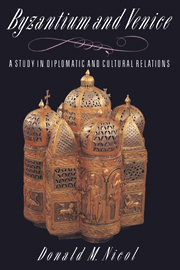Book contents
- Frontmatter
- Contents
- Dedication
- Preface
- List of abbreviations
- Maps of the Byzantine and Venetian worlds
- 1 Venice: the Byzantine province
- 2 Venice: the Byzantine protectorate
- 3 Venice: the ally of Byzantium
- 4 Venice: the partner of Byzantium
- 5 Byzantium, Venice and the First Crusade
- 6 The parting of the ways
- 7 The calm before the storm
- 8 The Fourth Crusade
- 9 Venice in Byzantium: the Empire of Romania
- 10 Venice: champion of a lost cause
- 11 Byzantium, Venice and the Angevin threat
- 12 Byzantium, Venice and Genoa
- 13 Conflicting interests and competing claims
- 14 Byzantium, Venice and the Turks
- 15 Byzantium: the victim of commercial rivalry
- 16 The profit and honour of Venice
- 17 Jewels for an island
- 18 Byzantium in thrall to the Turks and in debt to Venice
- 19 Byzantine optimism and Venetian vacillation
- 20 Byzantium the suppliant of Venice
- 21 The worst news for all of Christendom: Venice and the fall of Constantinople
- 22 Legacies and debts
- Byzantine Emperors
- Doges of Venice
- Bibliography
- Index
10 - Venice: champion of a lost cause
Published online by Cambridge University Press: 01 April 2010
- Frontmatter
- Contents
- Dedication
- Preface
- List of abbreviations
- Maps of the Byzantine and Venetian worlds
- 1 Venice: the Byzantine province
- 2 Venice: the Byzantine protectorate
- 3 Venice: the ally of Byzantium
- 4 Venice: the partner of Byzantium
- 5 Byzantium, Venice and the First Crusade
- 6 The parting of the ways
- 7 The calm before the storm
- 8 The Fourth Crusade
- 9 Venice in Byzantium: the Empire of Romania
- 10 Venice: champion of a lost cause
- 11 Byzantium, Venice and the Angevin threat
- 12 Byzantium, Venice and Genoa
- 13 Conflicting interests and competing claims
- 14 Byzantium, Venice and the Turks
- 15 Byzantium: the victim of commercial rivalry
- 16 The profit and honour of Venice
- 17 Jewels for an island
- 18 Byzantium in thrall to the Turks and in debt to Venice
- 19 Byzantine optimism and Venetian vacillation
- 20 Byzantium the suppliant of Venice
- 21 The worst news for all of Christendom: Venice and the fall of Constantinople
- 22 Legacies and debts
- Byzantine Emperors
- Doges of Venice
- Bibliography
- Index
Summary
The chrysobull that Theodore Laskaris granted to Venice in 1∧19 was evidently no more than a gesture. It was never revoked, but it was never renewed. The greatest of the emperors at Nicaea, John III Vatatzes, who succeeded Laskaris in 1222, aimed to make his empire self-sufficient, not dependent for its economic survival on trade with the Italians. Nor was he keen to do business with them in Constantinople. If and when his ships sailed into the Golden Horn it would be to take the city from them, to overthrow the Latin regime and restore the Byzantine Empire. The regime was already tottering. Its new emperor, Robert of Courtenay (1221–8), was a self-indulgent youth with none of the adventurous spirit which had fired the leaders of the Fourth Crusade. The French principality in the Morea and the French Duchy of Athens and Thebes which they had founded seemed to have a future. But the Latin Empire of Constantinople, of which they were fiefs, could not survive without a new influx of manpower and resources. The first of its outposts to fall was the so-called Kingdom of Thessalonica. Theodore of Epiros had dealt a memorable blow to the Latin regime by capturing its emperor in 1217. In the next few years he capitalised on his success by expanding his dominions at the expense not only of the Latins in Thessaly but also of the Bulgarians in Macedonia. His supporters confidently predicted that Thessalonica would soon fall to him and that, once master of the second city of Byzantium, he would have a better claim to the imperial title than any emperor in Nicaea.
- Type
- Chapter
- Information
- Byzantium and VeniceA Study in Diplomatic and Cultural Relations, pp. 166 - 187Publisher: Cambridge University PressPrint publication year: 1989



